Construction Technology Report: Site Analysis and Service Arrangements
VerifiedAdded on 2023/01/19
|15
|4850
|43
Report
AI Summary
This report delves into the realm of construction technology, offering a comprehensive analysis of various aspects within the field. It begins by differentiating between residential, commercial, and industrial buildings, highlighting their unique characteristics and construction requirements. The report then explores functional characteristics and design criteria, emphasizing how building use informs these aspects and the promotion of sustainability in building projects. It further examines pre-designing studies, site information collection, and the functional and design criteria for primary and secondary elements. The report also discusses techniques for site remediation, substructure types, and supply arrangements for primary services, concluding with a discussion on the distribution of these services. Overall, the report provides a detailed overview of the construction technology landscape, encompassing design, sustainability, and service considerations.
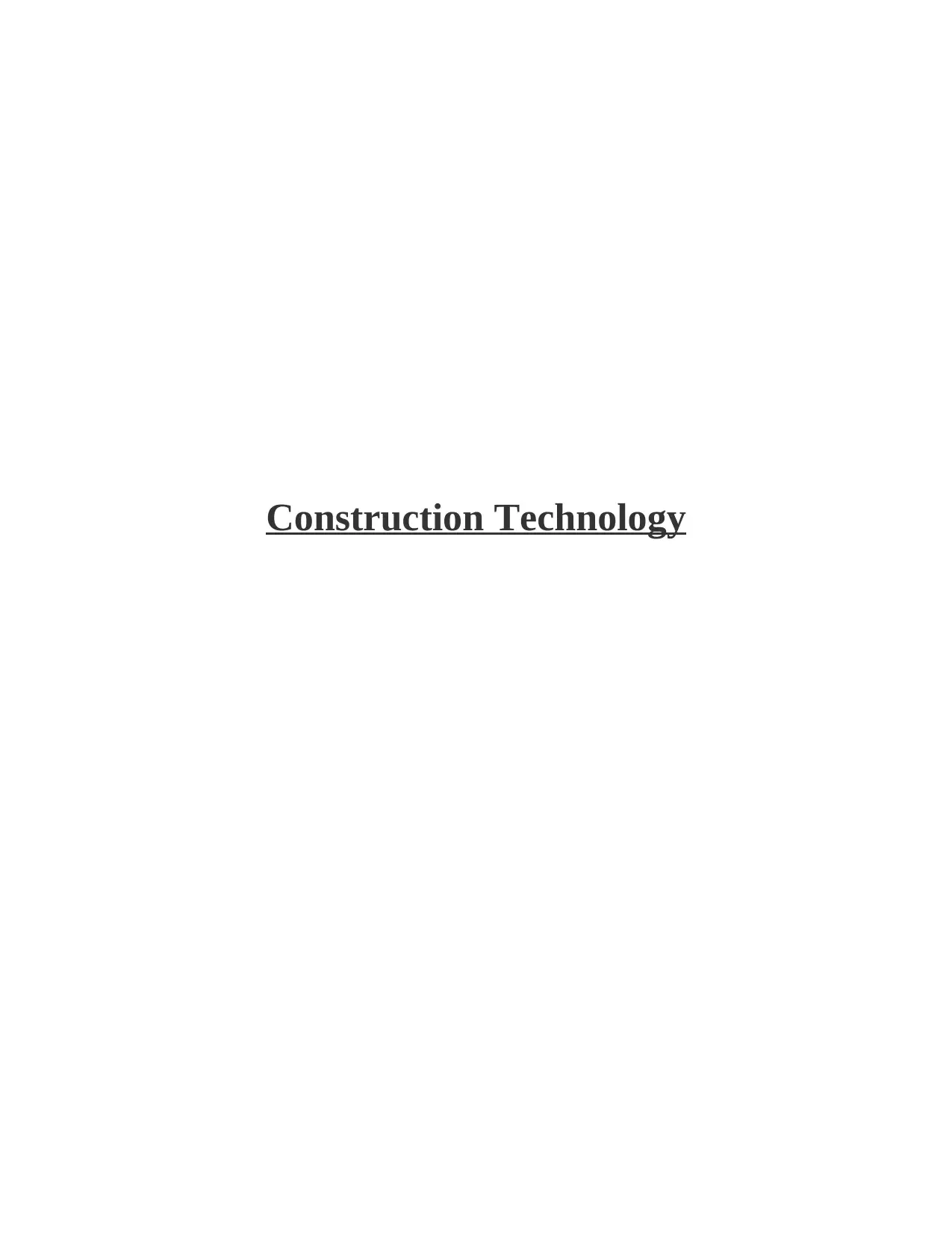
Construction Technology
Paraphrase This Document
Need a fresh take? Get an instant paraphrase of this document with our AI Paraphraser
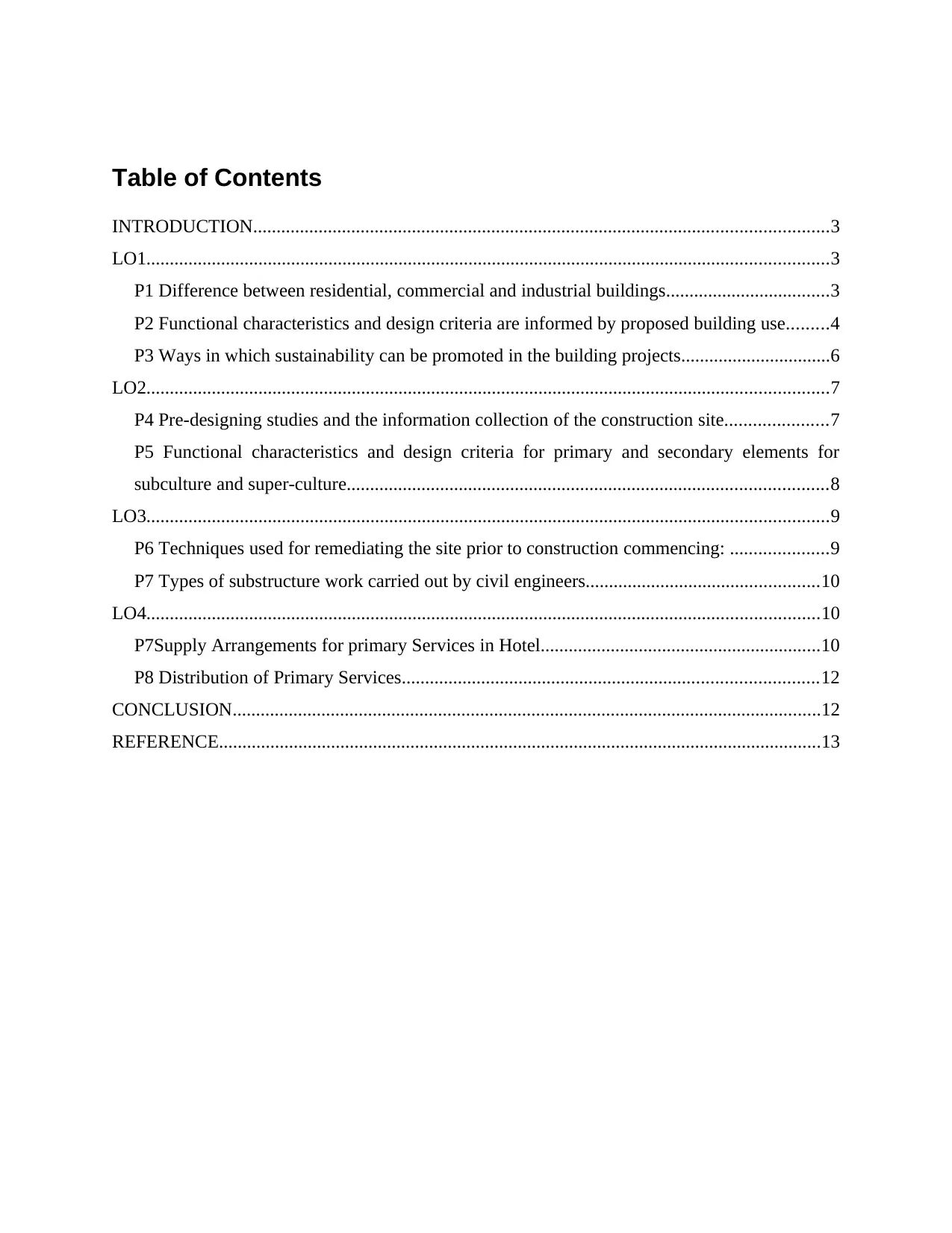
Table of Contents
INTRODUCTION...........................................................................................................................3
LO1..................................................................................................................................................3
P1 Difference between residential, commercial and industrial buildings...................................3
P2 Functional characteristics and design criteria are informed by proposed building use.........4
P3 Ways in which sustainability can be promoted in the building projects................................6
LO2..................................................................................................................................................7
P4 Pre-designing studies and the information collection of the construction site......................7
P5 Functional characteristics and design criteria for primary and secondary elements for
subculture and super-culture.......................................................................................................8
LO3..................................................................................................................................................9
P6 Techniques used for remediating the site prior to construction commencing: .....................9
P7 Types of substructure work carried out by civil engineers..................................................10
LO4................................................................................................................................................10
P7Supply Arrangements for primary Services in Hotel............................................................10
P8 Distribution of Primary Services.........................................................................................12
CONCLUSION..............................................................................................................................12
REFERENCE.................................................................................................................................13
INTRODUCTION...........................................................................................................................3
LO1..................................................................................................................................................3
P1 Difference between residential, commercial and industrial buildings...................................3
P2 Functional characteristics and design criteria are informed by proposed building use.........4
P3 Ways in which sustainability can be promoted in the building projects................................6
LO2..................................................................................................................................................7
P4 Pre-designing studies and the information collection of the construction site......................7
P5 Functional characteristics and design criteria for primary and secondary elements for
subculture and super-culture.......................................................................................................8
LO3..................................................................................................................................................9
P6 Techniques used for remediating the site prior to construction commencing: .....................9
P7 Types of substructure work carried out by civil engineers..................................................10
LO4................................................................................................................................................10
P7Supply Arrangements for primary Services in Hotel............................................................10
P8 Distribution of Primary Services.........................................................................................12
CONCLUSION..............................................................................................................................12
REFERENCE.................................................................................................................................13
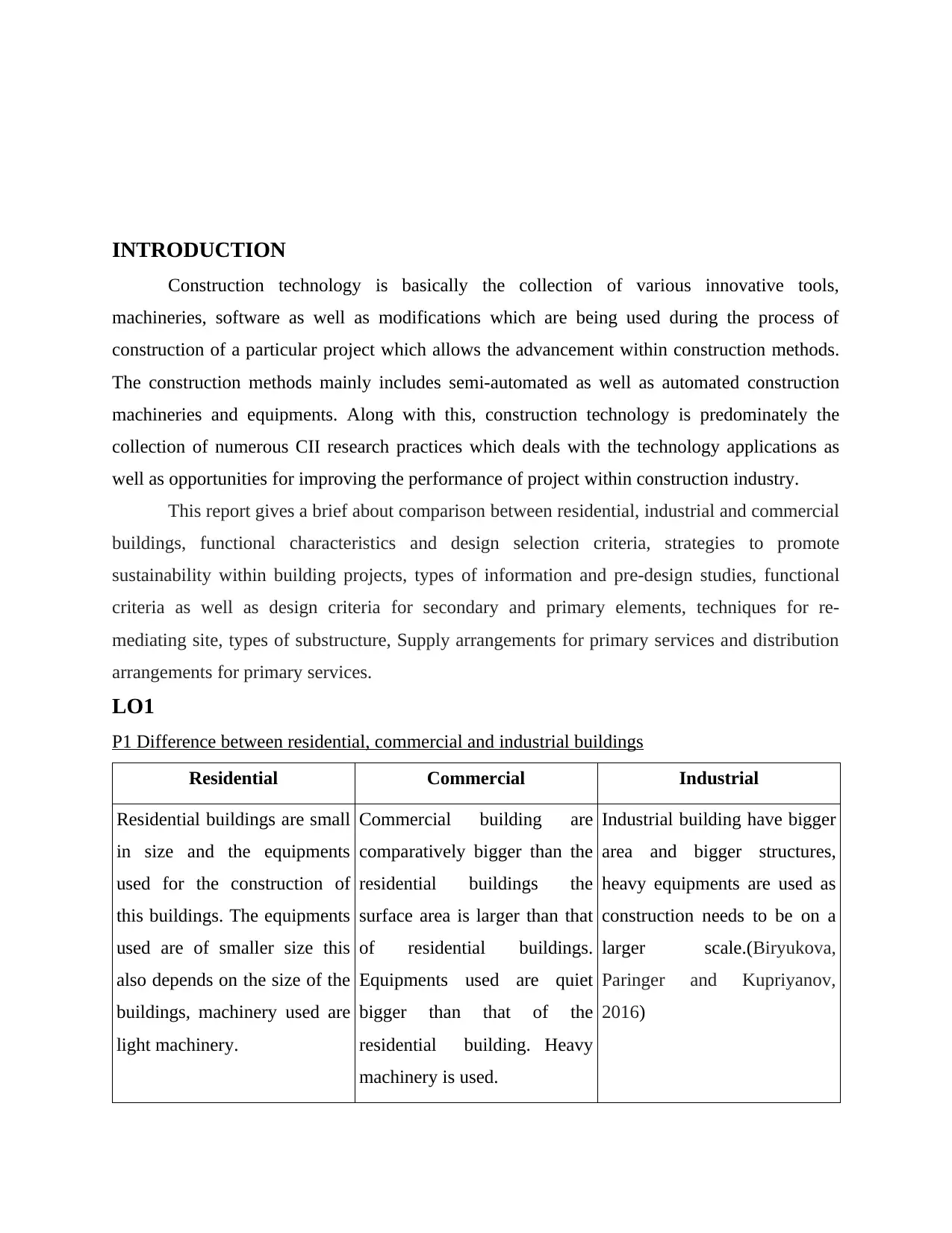
INTRODUCTION
Construction technology is basically the collection of various innovative tools,
machineries, software as well as modifications which are being used during the process of
construction of a particular project which allows the advancement within construction methods.
The construction methods mainly includes semi-automated as well as automated construction
machineries and equipments. Along with this, construction technology is predominately the
collection of numerous CII research practices which deals with the technology applications as
well as opportunities for improving the performance of project within construction industry.
This report gives a brief about comparison between residential, industrial and commercial
buildings, functional characteristics and design selection criteria, strategies to promote
sustainability within building projects, types of information and pre-design studies, functional
criteria as well as design criteria for secondary and primary elements, techniques for re-
mediating site, types of substructure, Supply arrangements for primary services and distribution
arrangements for primary services.
LO1
P1 Difference between residential, commercial and industrial buildings
Residential Commercial Industrial
Residential buildings are small
in size and the equipments
used for the construction of
this buildings. The equipments
used are of smaller size this
also depends on the size of the
buildings, machinery used are
light machinery.
Commercial building are
comparatively bigger than the
residential buildings the
surface area is larger than that
of residential buildings.
Equipments used are quiet
bigger than that of the
residential building. Heavy
machinery is used.
Industrial building have bigger
area and bigger structures,
heavy equipments are used as
construction needs to be on a
larger scale.(Biryukova,
Paringer and Kupriyanov,
2016)
Construction technology is basically the collection of various innovative tools,
machineries, software as well as modifications which are being used during the process of
construction of a particular project which allows the advancement within construction methods.
The construction methods mainly includes semi-automated as well as automated construction
machineries and equipments. Along with this, construction technology is predominately the
collection of numerous CII research practices which deals with the technology applications as
well as opportunities for improving the performance of project within construction industry.
This report gives a brief about comparison between residential, industrial and commercial
buildings, functional characteristics and design selection criteria, strategies to promote
sustainability within building projects, types of information and pre-design studies, functional
criteria as well as design criteria for secondary and primary elements, techniques for re-
mediating site, types of substructure, Supply arrangements for primary services and distribution
arrangements for primary services.
LO1
P1 Difference between residential, commercial and industrial buildings
Residential Commercial Industrial
Residential buildings are small
in size and the equipments
used for the construction of
this buildings. The equipments
used are of smaller size this
also depends on the size of the
buildings, machinery used are
light machinery.
Commercial building are
comparatively bigger than the
residential buildings the
surface area is larger than that
of residential buildings.
Equipments used are quiet
bigger than that of the
residential building. Heavy
machinery is used.
Industrial building have bigger
area and bigger structures,
heavy equipments are used as
construction needs to be on a
larger scale.(Biryukova,
Paringer and Kupriyanov,
2016)
⊘ This is a preview!⊘
Do you want full access?
Subscribe today to unlock all pages.

Trusted by 1+ million students worldwide
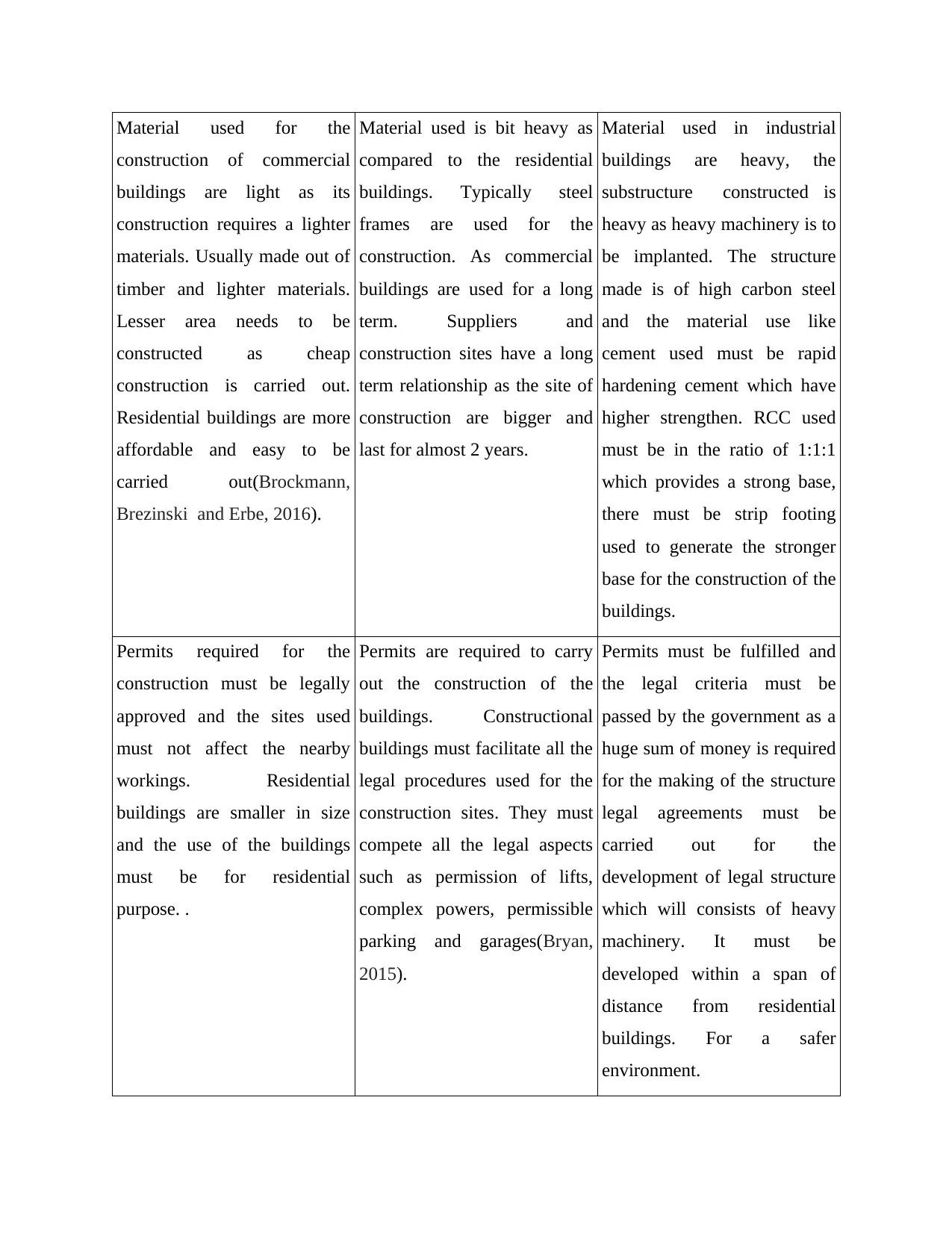
Material used for the
construction of commercial
buildings are light as its
construction requires a lighter
materials. Usually made out of
timber and lighter materials.
Lesser area needs to be
constructed as cheap
construction is carried out.
Residential buildings are more
affordable and easy to be
carried out(Brockmann,
Brezinski and Erbe, 2016).
Material used is bit heavy as
compared to the residential
buildings. Typically steel
frames are used for the
construction. As commercial
buildings are used for a long
term. Suppliers and
construction sites have a long
term relationship as the site of
construction are bigger and
last for almost 2 years.
Material used in industrial
buildings are heavy, the
substructure constructed is
heavy as heavy machinery is to
be implanted. The structure
made is of high carbon steel
and the material use like
cement used must be rapid
hardening cement which have
higher strengthen. RCC used
must be in the ratio of 1:1:1
which provides a strong base,
there must be strip footing
used to generate the stronger
base for the construction of the
buildings.
Permits required for the
construction must be legally
approved and the sites used
must not affect the nearby
workings. Residential
buildings are smaller in size
and the use of the buildings
must be for residential
purpose. .
Permits are required to carry
out the construction of the
buildings. Constructional
buildings must facilitate all the
legal procedures used for the
construction sites. They must
compete all the legal aspects
such as permission of lifts,
complex powers, permissible
parking and garages(Bryan,
2015).
Permits must be fulfilled and
the legal criteria must be
passed by the government as a
huge sum of money is required
for the making of the structure
legal agreements must be
carried out for the
development of legal structure
which will consists of heavy
machinery. It must be
developed within a span of
distance from residential
buildings. For a safer
environment.
construction of commercial
buildings are light as its
construction requires a lighter
materials. Usually made out of
timber and lighter materials.
Lesser area needs to be
constructed as cheap
construction is carried out.
Residential buildings are more
affordable and easy to be
carried out(Brockmann,
Brezinski and Erbe, 2016).
Material used is bit heavy as
compared to the residential
buildings. Typically steel
frames are used for the
construction. As commercial
buildings are used for a long
term. Suppliers and
construction sites have a long
term relationship as the site of
construction are bigger and
last for almost 2 years.
Material used in industrial
buildings are heavy, the
substructure constructed is
heavy as heavy machinery is to
be implanted. The structure
made is of high carbon steel
and the material use like
cement used must be rapid
hardening cement which have
higher strengthen. RCC used
must be in the ratio of 1:1:1
which provides a strong base,
there must be strip footing
used to generate the stronger
base for the construction of the
buildings.
Permits required for the
construction must be legally
approved and the sites used
must not affect the nearby
workings. Residential
buildings are smaller in size
and the use of the buildings
must be for residential
purpose. .
Permits are required to carry
out the construction of the
buildings. Constructional
buildings must facilitate all the
legal procedures used for the
construction sites. They must
compete all the legal aspects
such as permission of lifts,
complex powers, permissible
parking and garages(Bryan,
2015).
Permits must be fulfilled and
the legal criteria must be
passed by the government as a
huge sum of money is required
for the making of the structure
legal agreements must be
carried out for the
development of legal structure
which will consists of heavy
machinery. It must be
developed within a span of
distance from residential
buildings. For a safer
environment.
Paraphrase This Document
Need a fresh take? Get an instant paraphrase of this document with our AI Paraphraser
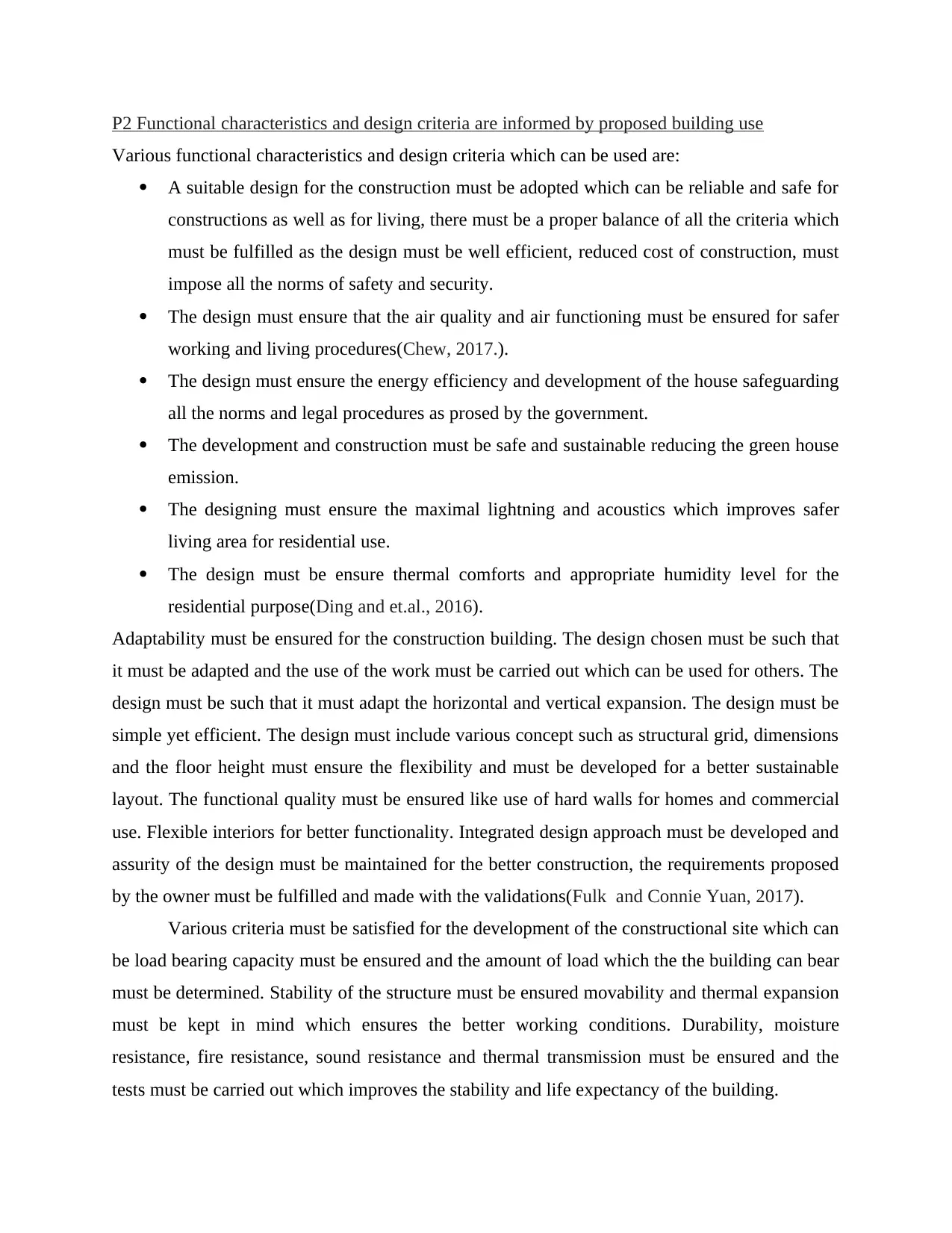
P2 Functional characteristics and design criteria are informed by proposed building use
Various functional characteristics and design criteria which can be used are:
A suitable design for the construction must be adopted which can be reliable and safe for
constructions as well as for living, there must be a proper balance of all the criteria which
must be fulfilled as the design must be well efficient, reduced cost of construction, must
impose all the norms of safety and security.
The design must ensure that the air quality and air functioning must be ensured for safer
working and living procedures(Chew, 2017.).
The design must ensure the energy efficiency and development of the house safeguarding
all the norms and legal procedures as prosed by the government.
The development and construction must be safe and sustainable reducing the green house
emission.
The designing must ensure the maximal lightning and acoustics which improves safer
living area for residential use.
The design must be ensure thermal comforts and appropriate humidity level for the
residential purpose(Ding and et.al., 2016).
Adaptability must be ensured for the construction building. The design chosen must be such that
it must be adapted and the use of the work must be carried out which can be used for others. The
design must be such that it must adapt the horizontal and vertical expansion. The design must be
simple yet efficient. The design must include various concept such as structural grid, dimensions
and the floor height must ensure the flexibility and must be developed for a better sustainable
layout. The functional quality must be ensured like use of hard walls for homes and commercial
use. Flexible interiors for better functionality. Integrated design approach must be developed and
assurity of the design must be maintained for the better construction, the requirements proposed
by the owner must be fulfilled and made with the validations(Fulk and Connie Yuan, 2017).
Various criteria must be satisfied for the development of the constructional site which can
be load bearing capacity must be ensured and the amount of load which the the building can bear
must be determined. Stability of the structure must be ensured movability and thermal expansion
must be kept in mind which ensures the better working conditions. Durability, moisture
resistance, fire resistance, sound resistance and thermal transmission must be ensured and the
tests must be carried out which improves the stability and life expectancy of the building.
Various functional characteristics and design criteria which can be used are:
A suitable design for the construction must be adopted which can be reliable and safe for
constructions as well as for living, there must be a proper balance of all the criteria which
must be fulfilled as the design must be well efficient, reduced cost of construction, must
impose all the norms of safety and security.
The design must ensure that the air quality and air functioning must be ensured for safer
working and living procedures(Chew, 2017.).
The design must ensure the energy efficiency and development of the house safeguarding
all the norms and legal procedures as prosed by the government.
The development and construction must be safe and sustainable reducing the green house
emission.
The designing must ensure the maximal lightning and acoustics which improves safer
living area for residential use.
The design must be ensure thermal comforts and appropriate humidity level for the
residential purpose(Ding and et.al., 2016).
Adaptability must be ensured for the construction building. The design chosen must be such that
it must be adapted and the use of the work must be carried out which can be used for others. The
design must be such that it must adapt the horizontal and vertical expansion. The design must be
simple yet efficient. The design must include various concept such as structural grid, dimensions
and the floor height must ensure the flexibility and must be developed for a better sustainable
layout. The functional quality must be ensured like use of hard walls for homes and commercial
use. Flexible interiors for better functionality. Integrated design approach must be developed and
assurity of the design must be maintained for the better construction, the requirements proposed
by the owner must be fulfilled and made with the validations(Fulk and Connie Yuan, 2017).
Various criteria must be satisfied for the development of the constructional site which can
be load bearing capacity must be ensured and the amount of load which the the building can bear
must be determined. Stability of the structure must be ensured movability and thermal expansion
must be kept in mind which ensures the better working conditions. Durability, moisture
resistance, fire resistance, sound resistance and thermal transmission must be ensured and the
tests must be carried out which improves the stability and life expectancy of the building.
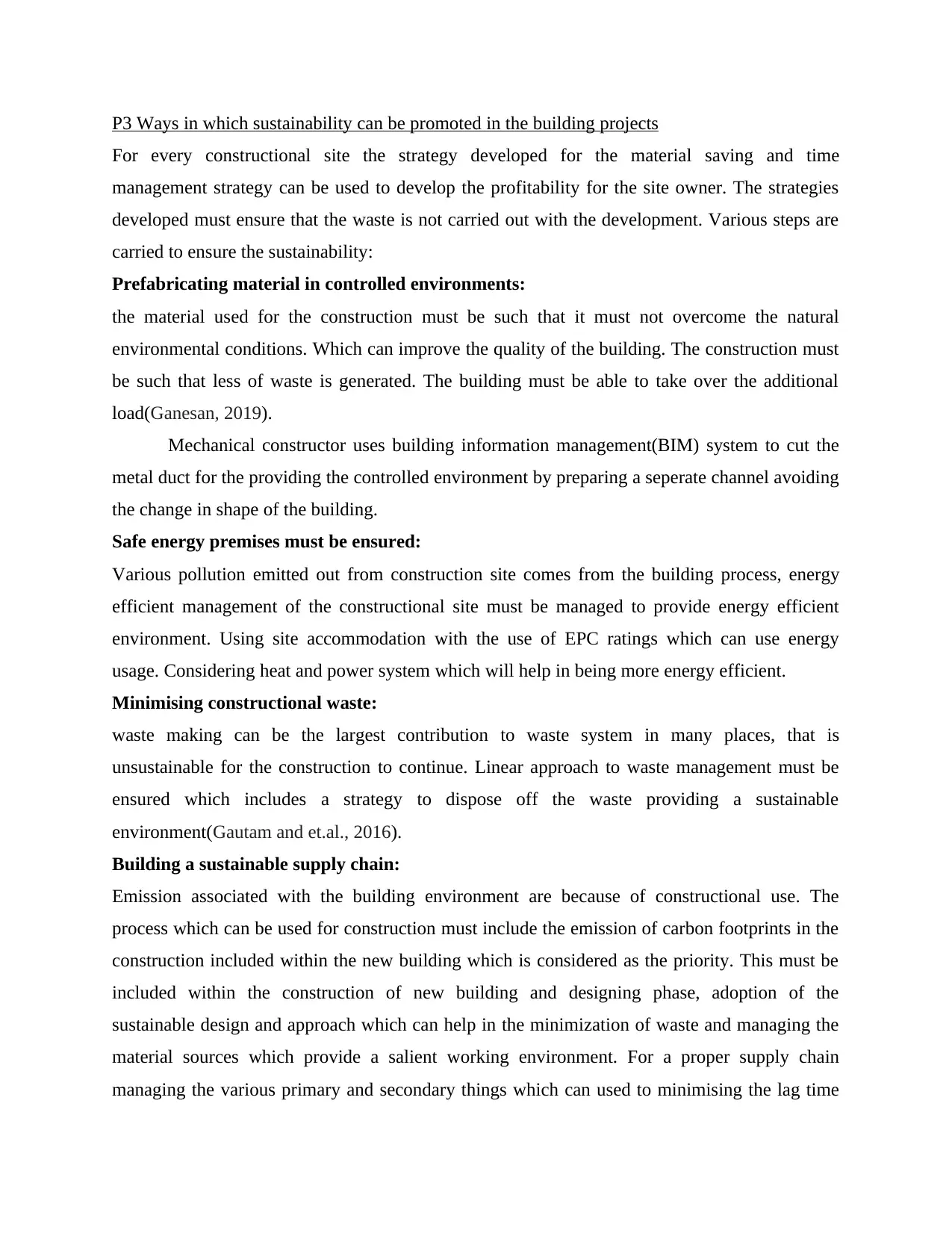
P3 Ways in which sustainability can be promoted in the building projects
For every constructional site the strategy developed for the material saving and time
management strategy can be used to develop the profitability for the site owner. The strategies
developed must ensure that the waste is not carried out with the development. Various steps are
carried to ensure the sustainability:
Prefabricating material in controlled environments:
the material used for the construction must be such that it must not overcome the natural
environmental conditions. Which can improve the quality of the building. The construction must
be such that less of waste is generated. The building must be able to take over the additional
load(Ganesan, 2019).
Mechanical constructor uses building information management(BIM) system to cut the
metal duct for the providing the controlled environment by preparing a seperate channel avoiding
the change in shape of the building.
Safe energy premises must be ensured:
Various pollution emitted out from construction site comes from the building process, energy
efficient management of the constructional site must be managed to provide energy efficient
environment. Using site accommodation with the use of EPC ratings which can use energy
usage. Considering heat and power system which will help in being more energy efficient.
Minimising constructional waste:
waste making can be the largest contribution to waste system in many places, that is
unsustainable for the construction to continue. Linear approach to waste management must be
ensured which includes a strategy to dispose off the waste providing a sustainable
environment(Gautam and et.al., 2016).
Building a sustainable supply chain:
Emission associated with the building environment are because of constructional use. The
process which can be used for construction must include the emission of carbon footprints in the
construction included within the new building which is considered as the priority. This must be
included within the construction of new building and designing phase, adoption of the
sustainable design and approach which can help in the minimization of waste and managing the
material sources which provide a salient working environment. For a proper supply chain
managing the various primary and secondary things which can used to minimising the lag time
For every constructional site the strategy developed for the material saving and time
management strategy can be used to develop the profitability for the site owner. The strategies
developed must ensure that the waste is not carried out with the development. Various steps are
carried to ensure the sustainability:
Prefabricating material in controlled environments:
the material used for the construction must be such that it must not overcome the natural
environmental conditions. Which can improve the quality of the building. The construction must
be such that less of waste is generated. The building must be able to take over the additional
load(Ganesan, 2019).
Mechanical constructor uses building information management(BIM) system to cut the
metal duct for the providing the controlled environment by preparing a seperate channel avoiding
the change in shape of the building.
Safe energy premises must be ensured:
Various pollution emitted out from construction site comes from the building process, energy
efficient management of the constructional site must be managed to provide energy efficient
environment. Using site accommodation with the use of EPC ratings which can use energy
usage. Considering heat and power system which will help in being more energy efficient.
Minimising constructional waste:
waste making can be the largest contribution to waste system in many places, that is
unsustainable for the construction to continue. Linear approach to waste management must be
ensured which includes a strategy to dispose off the waste providing a sustainable
environment(Gautam and et.al., 2016).
Building a sustainable supply chain:
Emission associated with the building environment are because of constructional use. The
process which can be used for construction must include the emission of carbon footprints in the
construction included within the new building which is considered as the priority. This must be
included within the construction of new building and designing phase, adoption of the
sustainable design and approach which can help in the minimization of waste and managing the
material sources which provide a salient working environment. For a proper supply chain
managing the various primary and secondary things which can used to minimising the lag time
⊘ This is a preview!⊘
Do you want full access?
Subscribe today to unlock all pages.

Trusted by 1+ million students worldwide
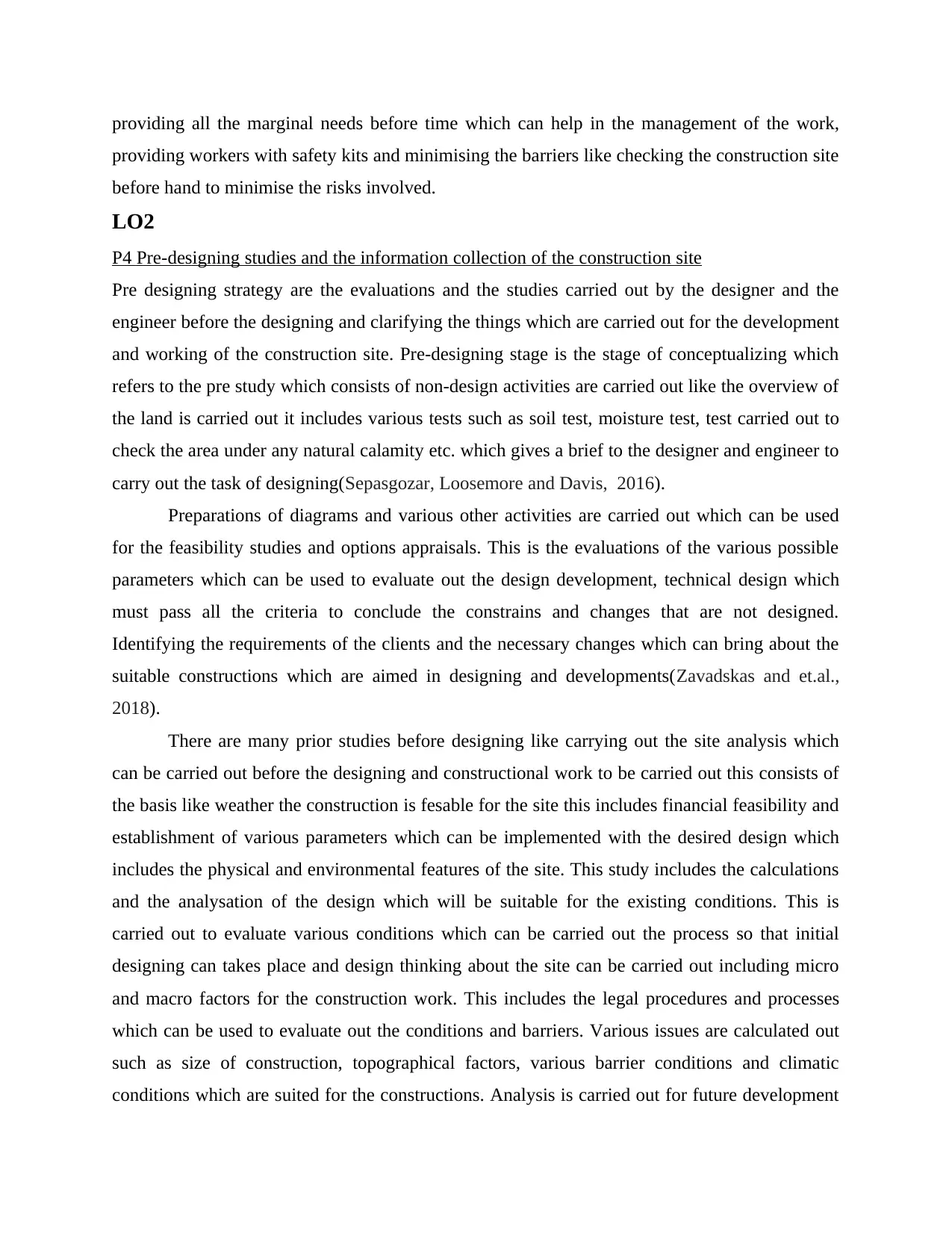
providing all the marginal needs before time which can help in the management of the work,
providing workers with safety kits and minimising the barriers like checking the construction site
before hand to minimise the risks involved.
LO2
P4 Pre-designing studies and the information collection of the construction site
Pre designing strategy are the evaluations and the studies carried out by the designer and the
engineer before the designing and clarifying the things which are carried out for the development
and working of the construction site. Pre-designing stage is the stage of conceptualizing which
refers to the pre study which consists of non-design activities are carried out like the overview of
the land is carried out it includes various tests such as soil test, moisture test, test carried out to
check the area under any natural calamity etc. which gives a brief to the designer and engineer to
carry out the task of designing(Sepasgozar, Loosemore and Davis, 2016).
Preparations of diagrams and various other activities are carried out which can be used
for the feasibility studies and options appraisals. This is the evaluations of the various possible
parameters which can be used to evaluate out the design development, technical design which
must pass all the criteria to conclude the constrains and changes that are not designed.
Identifying the requirements of the clients and the necessary changes which can bring about the
suitable constructions which are aimed in designing and developments(Zavadskas and et.al.,
2018).
There are many prior studies before designing like carrying out the site analysis which
can be carried out before the designing and constructional work to be carried out this consists of
the basis like weather the construction is fesable for the site this includes financial feasibility and
establishment of various parameters which can be implemented with the desired design which
includes the physical and environmental features of the site. This study includes the calculations
and the analysation of the design which will be suitable for the existing conditions. This is
carried out to evaluate various conditions which can be carried out the process so that initial
designing can takes place and design thinking about the site can be carried out including micro
and macro factors for the construction work. This includes the legal procedures and processes
which can be used to evaluate out the conditions and barriers. Various issues are calculated out
such as size of construction, topographical factors, various barrier conditions and climatic
conditions which are suited for the constructions. Analysis is carried out for future development
providing workers with safety kits and minimising the barriers like checking the construction site
before hand to minimise the risks involved.
LO2
P4 Pre-designing studies and the information collection of the construction site
Pre designing strategy are the evaluations and the studies carried out by the designer and the
engineer before the designing and clarifying the things which are carried out for the development
and working of the construction site. Pre-designing stage is the stage of conceptualizing which
refers to the pre study which consists of non-design activities are carried out like the overview of
the land is carried out it includes various tests such as soil test, moisture test, test carried out to
check the area under any natural calamity etc. which gives a brief to the designer and engineer to
carry out the task of designing(Sepasgozar, Loosemore and Davis, 2016).
Preparations of diagrams and various other activities are carried out which can be used
for the feasibility studies and options appraisals. This is the evaluations of the various possible
parameters which can be used to evaluate out the design development, technical design which
must pass all the criteria to conclude the constrains and changes that are not designed.
Identifying the requirements of the clients and the necessary changes which can bring about the
suitable constructions which are aimed in designing and developments(Zavadskas and et.al.,
2018).
There are many prior studies before designing like carrying out the site analysis which
can be carried out before the designing and constructional work to be carried out this consists of
the basis like weather the construction is fesable for the site this includes financial feasibility and
establishment of various parameters which can be implemented with the desired design which
includes the physical and environmental features of the site. This study includes the calculations
and the analysation of the design which will be suitable for the existing conditions. This is
carried out to evaluate various conditions which can be carried out the process so that initial
designing can takes place and design thinking about the site can be carried out including micro
and macro factors for the construction work. This includes the legal procedures and processes
which can be used to evaluate out the conditions and barriers. Various issues are calculated out
such as size of construction, topographical factors, various barrier conditions and climatic
conditions which are suited for the constructions. Analysis is carried out for future development
Paraphrase This Document
Need a fresh take? Get an instant paraphrase of this document with our AI Paraphraser
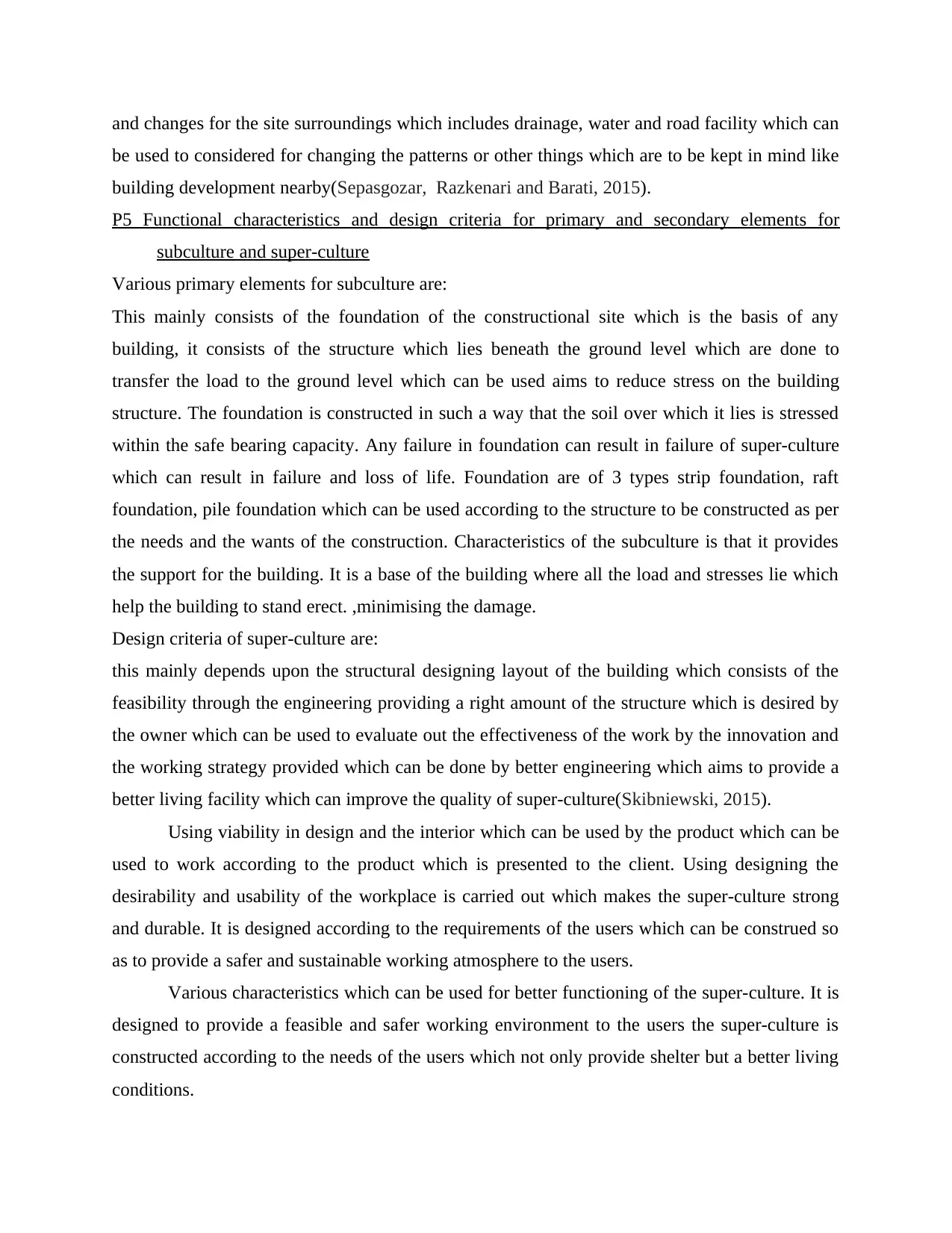
and changes for the site surroundings which includes drainage, water and road facility which can
be used to considered for changing the patterns or other things which are to be kept in mind like
building development nearby(Sepasgozar, Razkenari and Barati, 2015).
P5 Functional characteristics and design criteria for primary and secondary elements for
subculture and super-culture
Various primary elements for subculture are:
This mainly consists of the foundation of the constructional site which is the basis of any
building, it consists of the structure which lies beneath the ground level which are done to
transfer the load to the ground level which can be used aims to reduce stress on the building
structure. The foundation is constructed in such a way that the soil over which it lies is stressed
within the safe bearing capacity. Any failure in foundation can result in failure of super-culture
which can result in failure and loss of life. Foundation are of 3 types strip foundation, raft
foundation, pile foundation which can be used according to the structure to be constructed as per
the needs and the wants of the construction. Characteristics of the subculture is that it provides
the support for the building. It is a base of the building where all the load and stresses lie which
help the building to stand erect. ,minimising the damage.
Design criteria of super-culture are:
this mainly depends upon the structural designing layout of the building which consists of the
feasibility through the engineering providing a right amount of the structure which is desired by
the owner which can be used to evaluate out the effectiveness of the work by the innovation and
the working strategy provided which can be done by better engineering which aims to provide a
better living facility which can improve the quality of super-culture(Skibniewski, 2015).
Using viability in design and the interior which can be used by the product which can be
used to work according to the product which is presented to the client. Using designing the
desirability and usability of the workplace is carried out which makes the super-culture strong
and durable. It is designed according to the requirements of the users which can be construed so
as to provide a safer and sustainable working atmosphere to the users.
Various characteristics which can be used for better functioning of the super-culture. It is
designed to provide a feasible and safer working environment to the users the super-culture is
constructed according to the needs of the users which not only provide shelter but a better living
conditions.
be used to considered for changing the patterns or other things which are to be kept in mind like
building development nearby(Sepasgozar, Razkenari and Barati, 2015).
P5 Functional characteristics and design criteria for primary and secondary elements for
subculture and super-culture
Various primary elements for subculture are:
This mainly consists of the foundation of the constructional site which is the basis of any
building, it consists of the structure which lies beneath the ground level which are done to
transfer the load to the ground level which can be used aims to reduce stress on the building
structure. The foundation is constructed in such a way that the soil over which it lies is stressed
within the safe bearing capacity. Any failure in foundation can result in failure of super-culture
which can result in failure and loss of life. Foundation are of 3 types strip foundation, raft
foundation, pile foundation which can be used according to the structure to be constructed as per
the needs and the wants of the construction. Characteristics of the subculture is that it provides
the support for the building. It is a base of the building where all the load and stresses lie which
help the building to stand erect. ,minimising the damage.
Design criteria of super-culture are:
this mainly depends upon the structural designing layout of the building which consists of the
feasibility through the engineering providing a right amount of the structure which is desired by
the owner which can be used to evaluate out the effectiveness of the work by the innovation and
the working strategy provided which can be done by better engineering which aims to provide a
better living facility which can improve the quality of super-culture(Skibniewski, 2015).
Using viability in design and the interior which can be used by the product which can be
used to work according to the product which is presented to the client. Using designing the
desirability and usability of the workplace is carried out which makes the super-culture strong
and durable. It is designed according to the requirements of the users which can be construed so
as to provide a safer and sustainable working atmosphere to the users.
Various characteristics which can be used for better functioning of the super-culture. It is
designed to provide a feasible and safer working environment to the users the super-culture is
constructed according to the needs of the users which not only provide shelter but a better living
conditions.
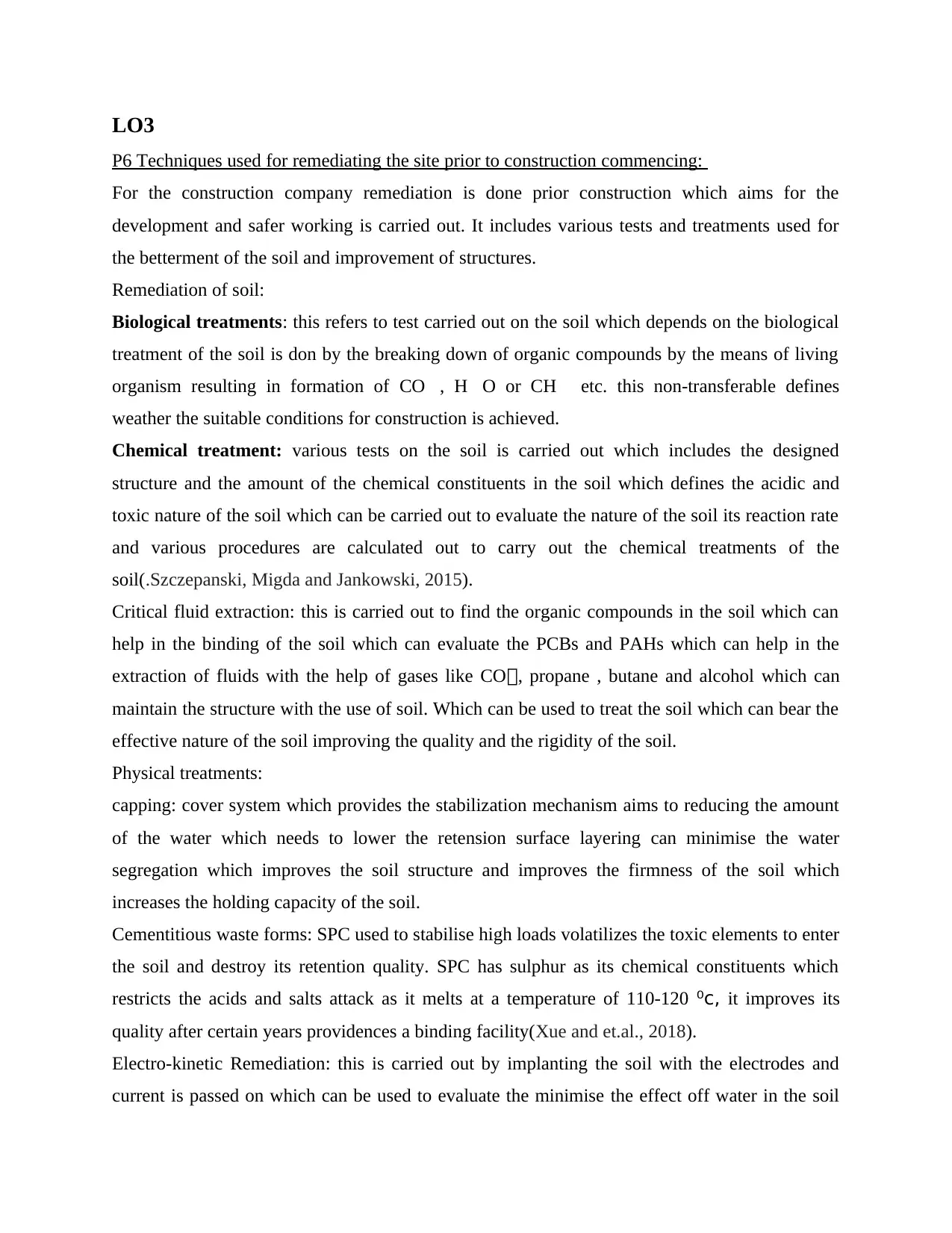
LO3
P6 Techniques used for remediating the site prior to construction commencing:
For the construction company remediation is done prior construction which aims for the
development and safer working is carried out. It includes various tests and treatments used for
the betterment of the soil and improvement of structures.
Remediation of soil:
Biological treatments: this refers to test carried out on the soil which depends on the biological
treatment of the soil is don by the breaking down of organic compounds by the means of living
organism resulting in formation of CO, HO or CH etc. this non-transferable defines
weather the suitable conditions for construction is achieved.
Chemical treatment: various tests on the soil is carried out which includes the designed
structure and the amount of the chemical constituents in the soil which defines the acidic and
toxic nature of the soil which can be carried out to evaluate the nature of the soil its reaction rate
and various procedures are calculated out to carry out the chemical treatments of the
soil(.Szczepanski, Migda and Jankowski, 2015).
Critical fluid extraction: this is carried out to find the organic compounds in the soil which can
help in the binding of the soil which can evaluate the PCBs and PAHs which can help in the
extraction of fluids with the help of gases like CO, propane , butane and alcohol which can
maintain the structure with the use of soil. Which can be used to treat the soil which can bear the
effective nature of the soil improving the quality and the rigidity of the soil.
Physical treatments:
capping: cover system which provides the stabilization mechanism aims to reducing the amount
of the water which needs to lower the retension surface layering can minimise the water
segregation which improves the soil structure and improves the firmness of the soil which
increases the holding capacity of the soil.
Cementitious waste forms: SPC used to stabilise high loads volatilizes the toxic elements to enter
the soil and destroy its retention quality. SPC has sulphur as its chemical constituents which
restricts the acids and salts attack as it melts at a temperature of 110-120 ⁰c, it improves its
quality after certain years providences a binding facility(Xue and et.al., 2018).
Electro-kinetic Remediation: this is carried out by implanting the soil with the electrodes and
current is passed on which can be used to evaluate the minimise the effect off water in the soil
P6 Techniques used for remediating the site prior to construction commencing:
For the construction company remediation is done prior construction which aims for the
development and safer working is carried out. It includes various tests and treatments used for
the betterment of the soil and improvement of structures.
Remediation of soil:
Biological treatments: this refers to test carried out on the soil which depends on the biological
treatment of the soil is don by the breaking down of organic compounds by the means of living
organism resulting in formation of CO, HO or CH etc. this non-transferable defines
weather the suitable conditions for construction is achieved.
Chemical treatment: various tests on the soil is carried out which includes the designed
structure and the amount of the chemical constituents in the soil which defines the acidic and
toxic nature of the soil which can be carried out to evaluate the nature of the soil its reaction rate
and various procedures are calculated out to carry out the chemical treatments of the
soil(.Szczepanski, Migda and Jankowski, 2015).
Critical fluid extraction: this is carried out to find the organic compounds in the soil which can
help in the binding of the soil which can evaluate the PCBs and PAHs which can help in the
extraction of fluids with the help of gases like CO, propane , butane and alcohol which can
maintain the structure with the use of soil. Which can be used to treat the soil which can bear the
effective nature of the soil improving the quality and the rigidity of the soil.
Physical treatments:
capping: cover system which provides the stabilization mechanism aims to reducing the amount
of the water which needs to lower the retension surface layering can minimise the water
segregation which improves the soil structure and improves the firmness of the soil which
increases the holding capacity of the soil.
Cementitious waste forms: SPC used to stabilise high loads volatilizes the toxic elements to enter
the soil and destroy its retention quality. SPC has sulphur as its chemical constituents which
restricts the acids and salts attack as it melts at a temperature of 110-120 ⁰c, it improves its
quality after certain years providences a binding facility(Xue and et.al., 2018).
Electro-kinetic Remediation: this is carried out by implanting the soil with the electrodes and
current is passed on which can be used to evaluate the minimise the effect off water in the soil
⊘ This is a preview!⊘
Do you want full access?
Subscribe today to unlock all pages.

Trusted by 1+ million students worldwide
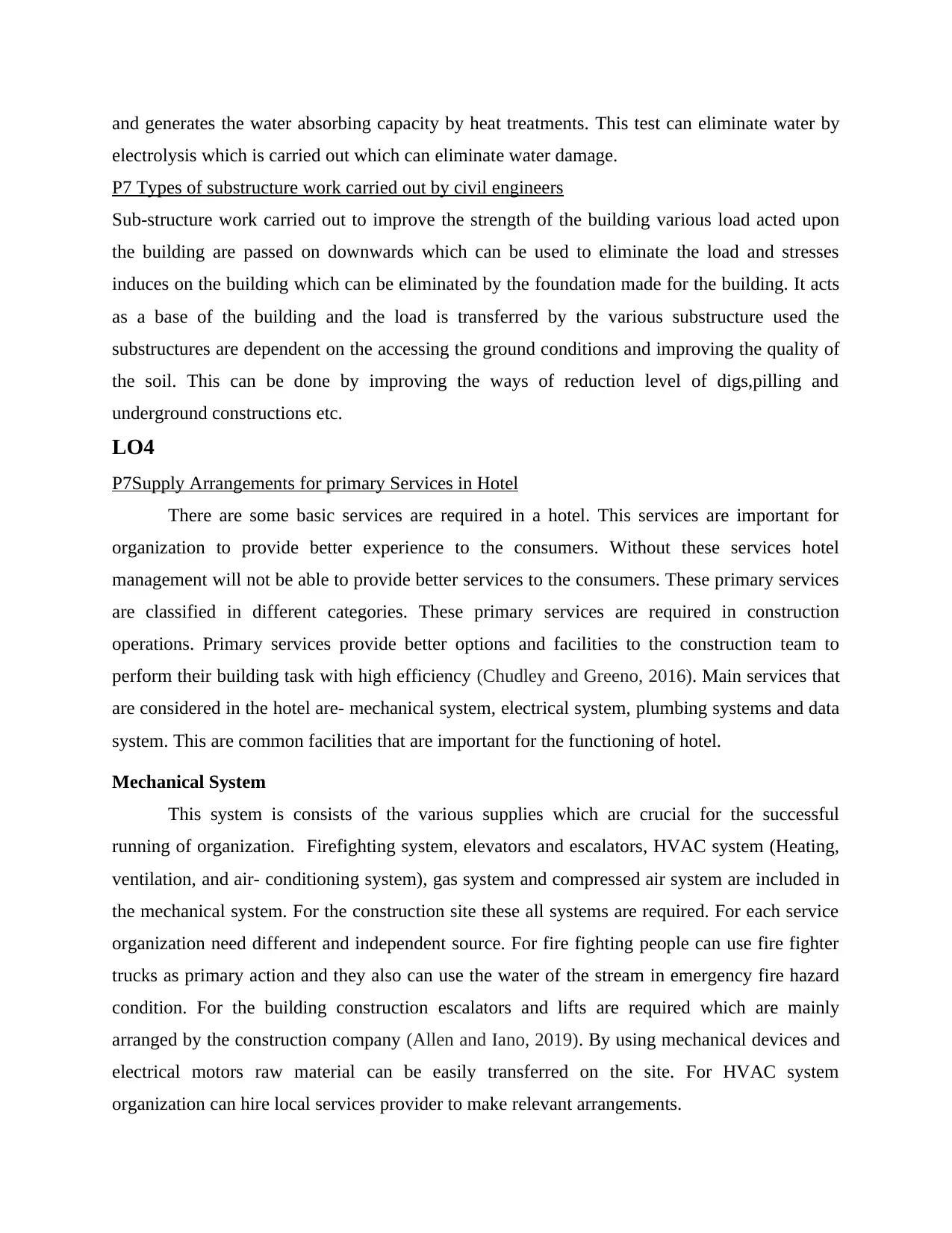
and generates the water absorbing capacity by heat treatments. This test can eliminate water by
electrolysis which is carried out which can eliminate water damage.
P7 Types of substructure work carried out by civil engineers
Sub-structure work carried out to improve the strength of the building various load acted upon
the building are passed on downwards which can be used to eliminate the load and stresses
induces on the building which can be eliminated by the foundation made for the building. It acts
as a base of the building and the load is transferred by the various substructure used the
substructures are dependent on the accessing the ground conditions and improving the quality of
the soil. This can be done by improving the ways of reduction level of digs,pilling and
underground constructions etc.
LO4
P7Supply Arrangements for primary Services in Hotel
There are some basic services are required in a hotel. This services are important for
organization to provide better experience to the consumers. Without these services hotel
management will not be able to provide better services to the consumers. These primary services
are classified in different categories. These primary services are required in construction
operations. Primary services provide better options and facilities to the construction team to
perform their building task with high efficiency (Chudley and Greeno, 2016). Main services that
are considered in the hotel are- mechanical system, electrical system, plumbing systems and data
system. This are common facilities that are important for the functioning of hotel.
Mechanical System
This system is consists of the various supplies which are crucial for the successful
running of organization. Firefighting system, elevators and escalators, HVAC system (Heating,
ventilation, and air- conditioning system), gas system and compressed air system are included in
the mechanical system. For the construction site these all systems are required. For each service
organization need different and independent source. For fire fighting people can use fire fighter
trucks as primary action and they also can use the water of the stream in emergency fire hazard
condition. For the building construction escalators and lifts are required which are mainly
arranged by the construction company (Allen and Iano, 2019). By using mechanical devices and
electrical motors raw material can be easily transferred on the site. For HVAC system
organization can hire local services provider to make relevant arrangements.
electrolysis which is carried out which can eliminate water damage.
P7 Types of substructure work carried out by civil engineers
Sub-structure work carried out to improve the strength of the building various load acted upon
the building are passed on downwards which can be used to eliminate the load and stresses
induces on the building which can be eliminated by the foundation made for the building. It acts
as a base of the building and the load is transferred by the various substructure used the
substructures are dependent on the accessing the ground conditions and improving the quality of
the soil. This can be done by improving the ways of reduction level of digs,pilling and
underground constructions etc.
LO4
P7Supply Arrangements for primary Services in Hotel
There are some basic services are required in a hotel. This services are important for
organization to provide better experience to the consumers. Without these services hotel
management will not be able to provide better services to the consumers. These primary services
are classified in different categories. These primary services are required in construction
operations. Primary services provide better options and facilities to the construction team to
perform their building task with high efficiency (Chudley and Greeno, 2016). Main services that
are considered in the hotel are- mechanical system, electrical system, plumbing systems and data
system. This are common facilities that are important for the functioning of hotel.
Mechanical System
This system is consists of the various supplies which are crucial for the successful
running of organization. Firefighting system, elevators and escalators, HVAC system (Heating,
ventilation, and air- conditioning system), gas system and compressed air system are included in
the mechanical system. For the construction site these all systems are required. For each service
organization need different and independent source. For fire fighting people can use fire fighter
trucks as primary action and they also can use the water of the stream in emergency fire hazard
condition. For the building construction escalators and lifts are required which are mainly
arranged by the construction company (Allen and Iano, 2019). By using mechanical devices and
electrical motors raw material can be easily transferred on the site. For HVAC system
organization can hire local services provider to make relevant arrangements.
Paraphrase This Document
Need a fresh take? Get an instant paraphrase of this document with our AI Paraphraser
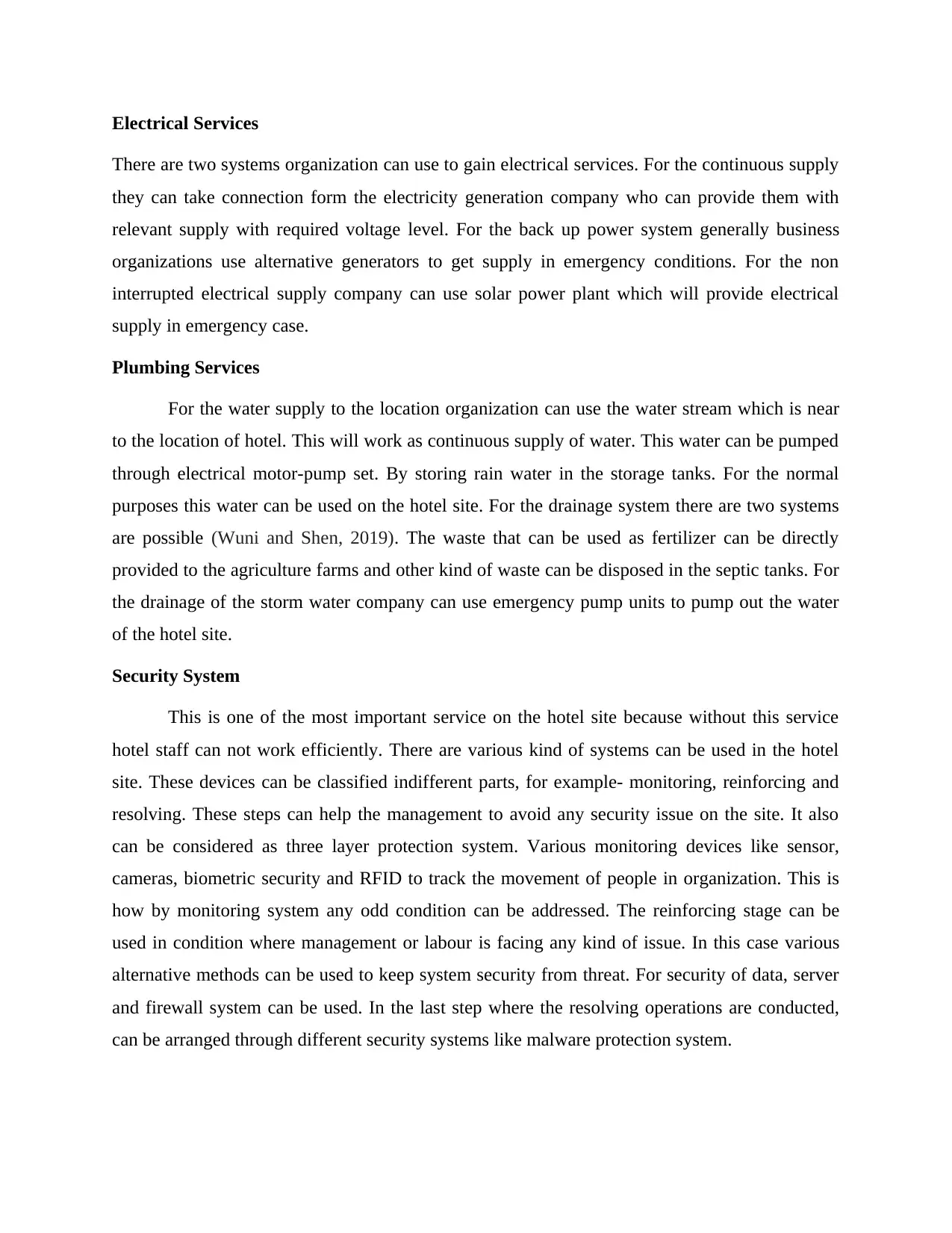
Electrical Services
There are two systems organization can use to gain electrical services. For the continuous supply
they can take connection form the electricity generation company who can provide them with
relevant supply with required voltage level. For the back up power system generally business
organizations use alternative generators to get supply in emergency conditions. For the non
interrupted electrical supply company can use solar power plant which will provide electrical
supply in emergency case.
Plumbing Services
For the water supply to the location organization can use the water stream which is near
to the location of hotel. This will work as continuous supply of water. This water can be pumped
through electrical motor-pump set. By storing rain water in the storage tanks. For the normal
purposes this water can be used on the hotel site. For the drainage system there are two systems
are possible (Wuni and Shen, 2019). The waste that can be used as fertilizer can be directly
provided to the agriculture farms and other kind of waste can be disposed in the septic tanks. For
the drainage of the storm water company can use emergency pump units to pump out the water
of the hotel site.
Security System
This is one of the most important service on the hotel site because without this service
hotel staff can not work efficiently. There are various kind of systems can be used in the hotel
site. These devices can be classified indifferent parts, for example- monitoring, reinforcing and
resolving. These steps can help the management to avoid any security issue on the site. It also
can be considered as three layer protection system. Various monitoring devices like sensor,
cameras, biometric security and RFID to track the movement of people in organization. This is
how by monitoring system any odd condition can be addressed. The reinforcing stage can be
used in condition where management or labour is facing any kind of issue. In this case various
alternative methods can be used to keep system security from threat. For security of data, server
and firewall system can be used. In the last step where the resolving operations are conducted,
can be arranged through different security systems like malware protection system.
There are two systems organization can use to gain electrical services. For the continuous supply
they can take connection form the electricity generation company who can provide them with
relevant supply with required voltage level. For the back up power system generally business
organizations use alternative generators to get supply in emergency conditions. For the non
interrupted electrical supply company can use solar power plant which will provide electrical
supply in emergency case.
Plumbing Services
For the water supply to the location organization can use the water stream which is near
to the location of hotel. This will work as continuous supply of water. This water can be pumped
through electrical motor-pump set. By storing rain water in the storage tanks. For the normal
purposes this water can be used on the hotel site. For the drainage system there are two systems
are possible (Wuni and Shen, 2019). The waste that can be used as fertilizer can be directly
provided to the agriculture farms and other kind of waste can be disposed in the septic tanks. For
the drainage of the storm water company can use emergency pump units to pump out the water
of the hotel site.
Security System
This is one of the most important service on the hotel site because without this service
hotel staff can not work efficiently. There are various kind of systems can be used in the hotel
site. These devices can be classified indifferent parts, for example- monitoring, reinforcing and
resolving. These steps can help the management to avoid any security issue on the site. It also
can be considered as three layer protection system. Various monitoring devices like sensor,
cameras, biometric security and RFID to track the movement of people in organization. This is
how by monitoring system any odd condition can be addressed. The reinforcing stage can be
used in condition where management or labour is facing any kind of issue. In this case various
alternative methods can be used to keep system security from threat. For security of data, server
and firewall system can be used. In the last step where the resolving operations are conducted,
can be arranged through different security systems like malware protection system.
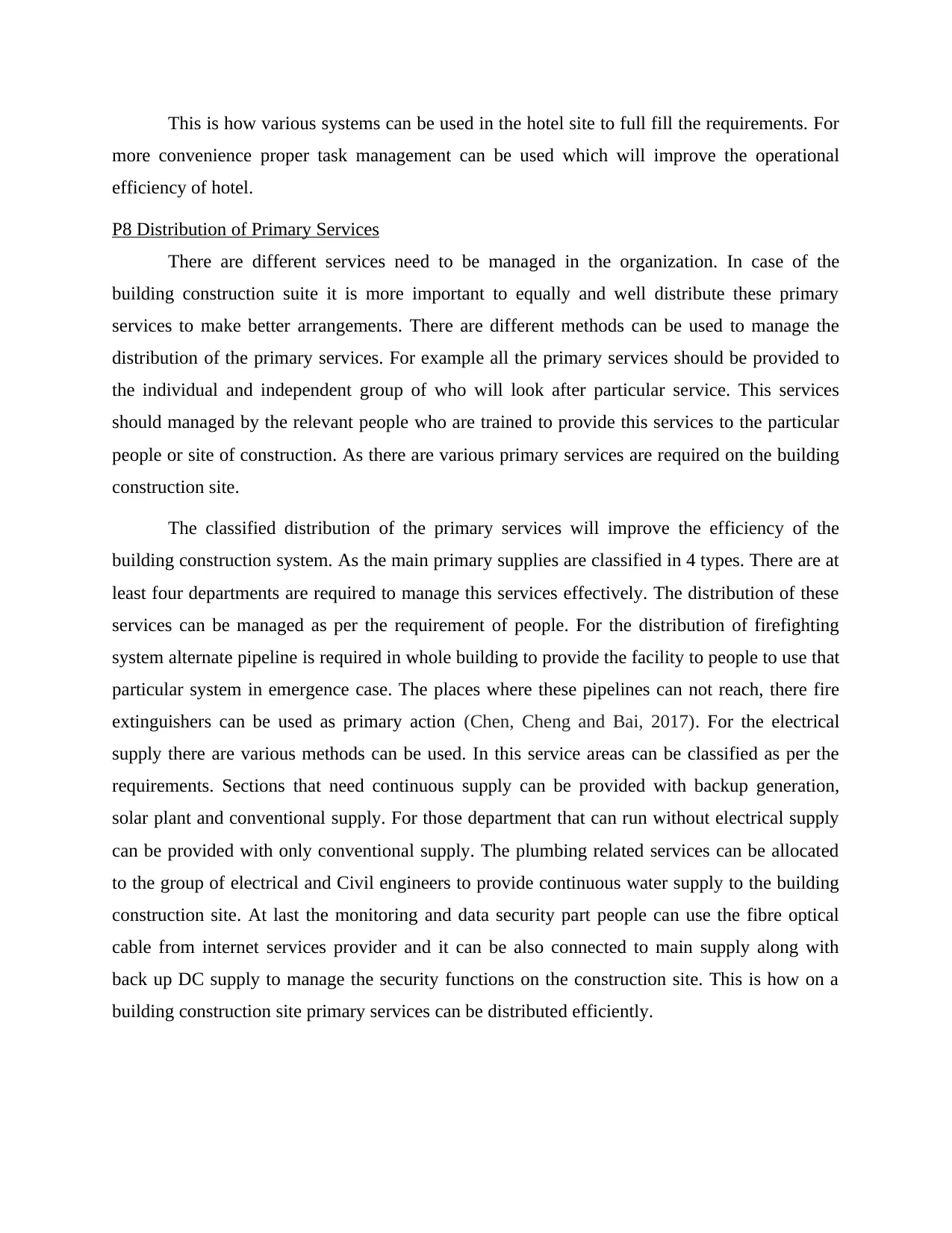
This is how various systems can be used in the hotel site to full fill the requirements. For
more convenience proper task management can be used which will improve the operational
efficiency of hotel.
P8 Distribution of Primary Services
There are different services need to be managed in the organization. In case of the
building construction suite it is more important to equally and well distribute these primary
services to make better arrangements. There are different methods can be used to manage the
distribution of the primary services. For example all the primary services should be provided to
the individual and independent group of who will look after particular service. This services
should managed by the relevant people who are trained to provide this services to the particular
people or site of construction. As there are various primary services are required on the building
construction site.
The classified distribution of the primary services will improve the efficiency of the
building construction system. As the main primary supplies are classified in 4 types. There are at
least four departments are required to manage this services effectively. The distribution of these
services can be managed as per the requirement of people. For the distribution of firefighting
system alternate pipeline is required in whole building to provide the facility to people to use that
particular system in emergence case. The places where these pipelines can not reach, there fire
extinguishers can be used as primary action (Chen, Cheng and Bai, 2017). For the electrical
supply there are various methods can be used. In this service areas can be classified as per the
requirements. Sections that need continuous supply can be provided with backup generation,
solar plant and conventional supply. For those department that can run without electrical supply
can be provided with only conventional supply. The plumbing related services can be allocated
to the group of electrical and Civil engineers to provide continuous water supply to the building
construction site. At last the monitoring and data security part people can use the fibre optical
cable from internet services provider and it can be also connected to main supply along with
back up DC supply to manage the security functions on the construction site. This is how on a
building construction site primary services can be distributed efficiently.
more convenience proper task management can be used which will improve the operational
efficiency of hotel.
P8 Distribution of Primary Services
There are different services need to be managed in the organization. In case of the
building construction suite it is more important to equally and well distribute these primary
services to make better arrangements. There are different methods can be used to manage the
distribution of the primary services. For example all the primary services should be provided to
the individual and independent group of who will look after particular service. This services
should managed by the relevant people who are trained to provide this services to the particular
people or site of construction. As there are various primary services are required on the building
construction site.
The classified distribution of the primary services will improve the efficiency of the
building construction system. As the main primary supplies are classified in 4 types. There are at
least four departments are required to manage this services effectively. The distribution of these
services can be managed as per the requirement of people. For the distribution of firefighting
system alternate pipeline is required in whole building to provide the facility to people to use that
particular system in emergence case. The places where these pipelines can not reach, there fire
extinguishers can be used as primary action (Chen, Cheng and Bai, 2017). For the electrical
supply there are various methods can be used. In this service areas can be classified as per the
requirements. Sections that need continuous supply can be provided with backup generation,
solar plant and conventional supply. For those department that can run without electrical supply
can be provided with only conventional supply. The plumbing related services can be allocated
to the group of electrical and Civil engineers to provide continuous water supply to the building
construction site. At last the monitoring and data security part people can use the fibre optical
cable from internet services provider and it can be also connected to main supply along with
back up DC supply to manage the security functions on the construction site. This is how on a
building construction site primary services can be distributed efficiently.
⊘ This is a preview!⊘
Do you want full access?
Subscribe today to unlock all pages.

Trusted by 1+ million students worldwide
1 out of 15
Related Documents
Your All-in-One AI-Powered Toolkit for Academic Success.
+13062052269
info@desklib.com
Available 24*7 on WhatsApp / Email
![[object Object]](/_next/static/media/star-bottom.7253800d.svg)
Unlock your academic potential
Copyright © 2020–2025 A2Z Services. All Rights Reserved. Developed and managed by ZUCOL.




